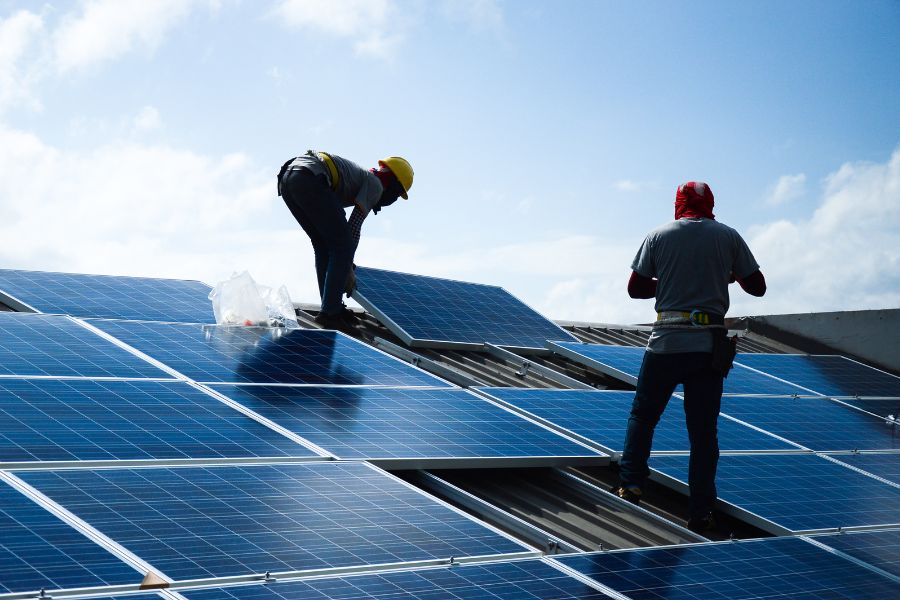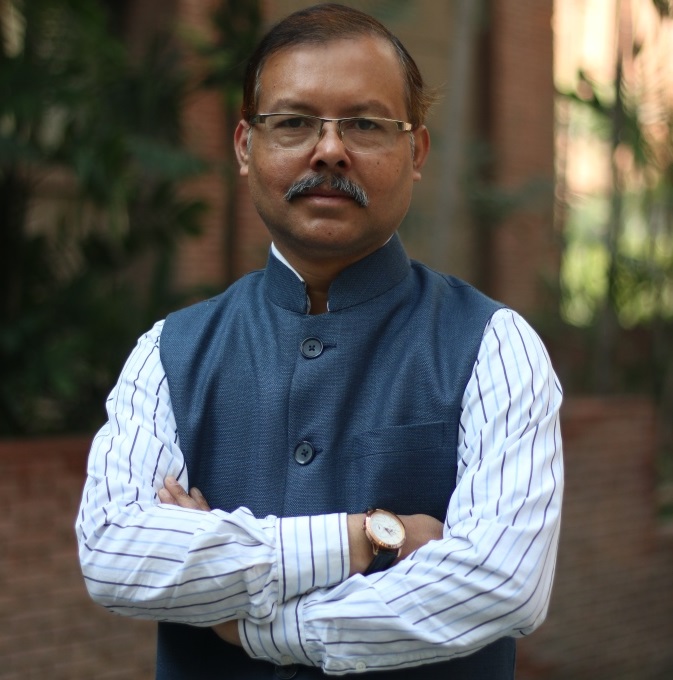“MSMEs’ participation in rooftop solar installation is crucial”
During COP26 (United Nations Climate Change Conference), India unveiled an ambitious goal to reach 500 GW of non-fossil fuel-based energy by the year 2030. By May 2023, the installed solar energy capacity has experienced substantial growth, surging by 24.4% over the last nine years, culminating in an impressive 66.7 GW.
As of March 2023, an additional 8,877 MW of rooftop solar capacity was integrated, primarily driven by heightened awareness among residential consumers and government subsidies targeted at the residential segment. Dr Debajit Palit, Professor at NTPC School of Business shares his views on the potential of the rooftop solar segment in India, as well as its expected progress in the coming years.

Image Source: Shutterstock
Solar rooftop additions have surged in the past two years with average installations crossing 2GW as of this date compared to average installations of just about 1.3 GW during FY20 and FY21. The total additions for FY23 (April-Feb) remained 1,843 MW, whereas, the additions for FY22 were 2,215 MW. This is major because of fewer challenges related to Rooftop solar as compared to other energy sources.
Why roof-top solar?
A significant advantage of the Rooftop Solar (RTS) is the reduction in transmission loss. When combined with energy storage systems and various distributed energy resources like peer-to-peer (P2P) energy sharing, the potential benefits become even more evident. As we move towards modern electric systems, rooftops are likely to play an increasingly important role, as already observed in several European countries, where distributed energy resources are implemented as “Energy Islands,” or in the U.S., where Blockchain and other technologies are being utilized for this purpose.
In India, we can expect similar developments in the coming years. However, it is crucial to approach these changes with caution, especially concerning the business models we adopt. Whether it’s a capex model or third-party-owned RTS systems, careful consideration must be given to the revenue structure. These decisions require thorough discussions and deliberations. Furthermore, there is still some confusion regarding gross metering and net metering, which needs to be addressed comprehensively.
Certain discoms are prioritizing gross metering, while others are leaning towards net metering. Under the gross metering arrangement, compensation to consumers is usually lower than the retail supply tariff, while under net metering since the import of power is adjusted against the export, the compensation is effectively at the retail supply tariff. As a revenue protection measure, discoms are inclined to adopt gross metering. Each approach comes with its own set of advantages and disadvantages for both consumers and the utility companies. Therefore, it is essential to find a middle ground and determine which option should be preferred or promoted. Perhaps, a balanced approach can be adopted by promoting both, depending on the specific needs and characteristics of different consumer segments. This way, we can strike a harmonious balance that benefits all stakeholders involved.
Blueprint for growth trajectory
Back in 2009-10, when rooftop solar and building-integrated solar initiatives were introduced, Ravi Rashmi Abasan, the first project was launched in Kolkata. During that period, discoms largely preferred net metering due to the high cost of solar power, while consumers were more inclined towards gross metering. However, the situation has now completely reversed.
- In order to progress without any undue bias, it is crucial for consumers and stakeholders to collaborate and find a common ground regarding the favoured model. By doing so, we can accelerate the implementation scale and reach a solution more promptly. Ultimately, finding a resolution that satisfies all parties involved will lead to increased adoption and expansion of these renewable energy initiatives.
- Additionally, the introduction of time-of-day pricing is necessary. Recently a solar tariff and a non-solar tariff have been introduced, but a comprehensive implementation is required. In India, policies are often well-conceived, but the challenge lies in their ground-level execution. As electricity is a concurrent subject, discrepancies between federal and state government policies and schemes can lead to conflicts and confusion among consumers. Avoiding such confusion & proper policy implementation should be a priority.
- Thirdly, there is significant potential in residential rooftop solar. Gujarat has demonstrated remarkable success in this area, with nearly 60 per cent of the total residential rooftop installations coming from the state. They have adopted a well-structured model, like in California. This model includes careful RESCO selection, demand aggregation, resource development, training, and awareness campaigns through various media channels. However, most states lack proper communication and coordination. It is crucial for them to share experiences and learn from each other. Kerala, for instance, is making great progress by aggregating demand. The Distribution Company has set up a cell in the Kerala State Electricity Board, conducting surveys to identify rooftop potential in every household. They have devised three different implementation models: RESCO-based, EPC or capex-based, and a hybrid model, which is now being put into action.
Therefore, it is crucial for other states to implement these measures and exchange knowledge to foster sector growth. Additionally, I must highlight the existing confusion among consumers regarding the national rooftop portal. Although it has been launched, there is inadequate awareness about it. Many people approach me with questions about subsidies, the application process, and whether to apply through the discom or directly on the National Portal.
To address this, we need a comprehensive awareness campaign, similar to the one conducted by the Bureau of Energy Efficiency in the past to promote energy efficient systems & star levelling. By doing so, we can empower consumers and enable them to make informed decisions regarding rooftop solar adoption. In the past, successful campaigns were carried out by creating a mascot and utilizing various media channels to reach every household by many government programs. To ensure the success of the rooftop solar program nationwide, a similar campaign is essential. This effort should not only target urban households but also reach those in rural areas, as there is significant untapped potential in both residential and institutional rooftops. Similar initiatives have proven effective in other countries, and we must follow suit to unlock the full potential of solar energy in our nation.
Let’s consider the example of the Delhi Metro. To achieve the 500-gigawatt non-fossil fuel energy target, it’s essential to install solar panels on all south-facing shadow-free elevated corridors of the Delhi Metro. Utilizing available spaces for solar energy generation is crucial, as land availability could become an issue otherwise. While floating solar is gaining popularity, it’s important to be mindful of its potential impact on aquatic biodiversity.
To make progress towards the target, solar installations should be integrated wherever possible. For instance, rooftops & elevated metro lines, flyovers, carports, institutional buildings, stadiums, warehouses and even spaces around railway stations are ideal candidates for solar panel installations. This approach can be a significant step in harnessing solar energy efficiently and sustainably.
Significance of regulatory framework
The primary focus of the regulatory framework should be to provide clear guidelines. Whether the regulators opt for net metering, gross metering, or a combination of both, it is essential to establish unambiguous clarity in their decision.
Secondly, implementing time-of-use pricing can significantly incentivize consumers to adopt rooftop solar in their homes. Clear pricing based on different times of the day can help consumers understand the benefits and reasons for installing solar panels on their rooftops.
Thirdly, the government must foster the growth of a substantial base of RESCOs (Renewable Energy Service Company) or ESCOs (Energy Service Company) in the rooftop solar market. Many consumers may not be willing to make a full upfront investment for rooftop installations, but they might be open to providing monthly payments. Therefore, having energy service companies that can undertake these rooftop solar projects, either through leasing the rooftops or on behalf of the consumers, is crucial. These companies can facilitate the adoption of rooftop solar by making it more accessible and financially viable for a broader range of consumers. Such ESCOs may have to be provided with incentives or soft loans for making capital investments.
Opportunities in the roof-top solar segment in India
In order to facilitate the transition to solar, there is a need for a considerable number of installers since the presence of ESCOs in India is limited. Therefore, it is essential for the government to foster an ecosystem that encourages the growth of more ESCOs. These companies can play a pivotal role in guiding consumers through energy audits for their homes and demonstrating how rooftop solar can provide long-term benefits.
Furthermore, some of these ESCOs can evolve into energy trading companies in the future, especially with the increasing adoption of peer-to-peer energy sharing and Blockchain technology. Notably, the UP Electricity Regulatory Commission has recently released guidelines for P2P energy trading, and pilot projects are underway in cities like Delhi, Bangalore, and Kolkata, among others. The success of these initiatives is expected to encourage other states to develop their own guidelines, further advancing the growth of renewable energy, especially RTS, in the country.
Now, the question arises – who will be responsible for implementing these P2P systems? We require well-trained energy service companies to effectively implement this model, enabling them to engage with consumers and communicate the benefits of such systems. Consumers, in turn, can also earn money by sharing their excess energy with their neighbours. Clarity regarding the eligibility criteria and implementation process for virtual net metering is also essential, as it is a relatively new concept.
One area where rooftop solar adoption is lacking is in the MSME (Micro, Small, and Medium Enterprise) sector. While medium enterprises might have the financial capacity to set up solar systems, micro-enterprises, especially in rural areas, often lack the resources to do so. Addressing these challenges and providing support to the MSME sector can be instrumental in encouraging greater rooftop solar installations in this segment.
I firmly believe in the vast potential of supporting micro-enterprises through rooftop solar systems. During my tenure at TERI, I developed a model for implementing such systems in micro-enterprises located in Uttar Pradesh, and the results were highly promising. These installations not only help reduce daytime energy demand but also enable these enterprises to make a seamless transition to clean energy with proper guidance and support.
To materialize this vision, it is essential to continue nurturing the necessary ecosystem. The government can play a pivotal role by providing support to renewable energy development agencies, enabling them to facilitate the adoption of rooftop solar in micro-enterprises. Moreover, prioritizing skilling and licensing programs for installation and commissioning will ensure the safe and efficient implementation of solar projects. By taking a comprehensive approach, we can unlock the full potential of rooftop solar for micro-enterprises, making a significant positive impact on the overall energy landscape.
In India, the current situation permits anyone to install a rooftop solar system without taking into account their expertise or qualifications. This lack of clarity raises serious concerns about the quality of installations and whether the installers have the necessary certifications. In contrast, countries like Kenya provide certificates for all installers, ensuring a higher standard of professionalism and safety during the installation process.
The existence of India’s Surya Mitra program raises questions about its effectiveness and ability to generate employment opportunities for its participants. To address this issue, an alternative and more impactful approach could involve integrating the installation of distributed solar systems into the existing curriculum of Industrial Training Institutes (ITIs). A previous attempt was made in 2010 on behalf of the ministry to integrate this training, but its success and potential benefits should be reevaluated and further explored. By doing so, we can enhance the overall quality and standards of rooftop solar installations in the country.
Need to boost India’s domestic manufacturing
In today’s context, prioritizing local manufacturing is crucial, but we must proceed with caution. Every decision has its own advantages and disadvantages. For instance, due to the domestic content requirement, the price of solar has increased slightly because of the imposition of customs duty. As a result, there has been a slight reduction in installations compared to the previous year. However, it’s essential to recognize that this might be a short-term setback, and in the long run, fostering local manufacturing will yield significant benefits.
In the long term, developing domestic manufacturing capabilities in the solar sector may accelerate growth at a rapid pace. Furthermore, with the identification of lithium reserves in India, battery technology could also advance faster than anticipated, reducing our dependency on imports. Though short-term challenges may arise, enduring a bit of temporary difficulty for a few months or even a year could yield substantial benefits in the future.
According to government data, 65 gigawatts are planned under the second phase of the PLI scheme. Around 40 gigawatts are expected to be domestically consumed. This indicates that India is likely to become a significant exporting nation in the years to come. As domestic capacity grows and supply increases, solar prices are expected to decrease further. So, despite facing some short-term hardships, let us embrace this opportunity for a brighter and more promising future ahead.

Dr. Debajit Palit has more than 26 years of experience working in the domain of renewable energy, clean energy access, rural electrification, distributed generation, micro-grids and energy transition. He has been featured in the Top 2% of the World’s Scientists ranking by Stanford University for the last 3 years in a row. Presently, Dr Palit is a Professor of Energy at the NTPC School of Business, Noida.
He was earlier with The Energy and Resources Institute (TERI), a global research and policy think tank, as a Director and Senior Fellow, and led the Rural Energy & Livelihood Division in TERI for almost a decade. Dr Palit is also a visiting faculty member at the Anant Fellowship for Climate Action Programme, Vice President (Honorary) of the Indian Association for Energy Economics, Editorial Board Member of the Environmental Research Communications and a Member of the LVDC Distribution Systems Sectional Committee of the Bureau of Indian Standards.













Leave a comment